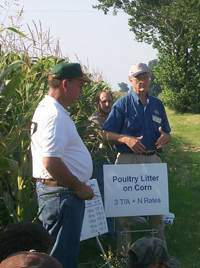Field Day Stop Highlights Animal Manure Use on Crop Production
Field Day Stop Highlights Animal Manure Use on Crop Production

On a blazing, late afternoon in far west Kentucky, farmers gathered to review corn plots fertilized in part with poultry litter, see University of Kentucky corn variety trials and hear the potential problems of planting corn after corn.
Farmers from throughout the Purchase area attended the July 31 event hosted by Fulton County that highlighted corn production and research efforts being done by the UK College of Agriculture.
With the influx of poultry operations into the state, researchers are looking to put manure to use as food for crops. And the research isn't limited to poultry litter. It encompasses all types of animal manure, using a computer worksheet that determines application rates developed by UK Extension specialists Frank Sikora, Monroe Rasnake and Bill Thom.
The worksheet includes a list of animal wastes and how they are applied to the soil to determine the amount of nitrogen available in the first year to the crop. It also factors-in previous manure applications, said Monroe Rasnake, Extension UK agronomist.
The computer worksheet can be used to record the crop to be planted, the amount of manure to be applied and the crop management type such as no-tillage, then it offers two ways to determine further nutrient needs. One method is to select a yield target while the other determines crop utilization of the applied nutrients.
Using this worksheet, the program will calibrate how much additional fertilizer is needed to reach the farmer's crop goal.
The idea is to allow farmers to be efficient in their use of manure and commercial fertilizer by using only what is needed, Rasnake said. This reduces costs to the farmer and reduces the chance of run off.
The test plots on Rob Garrigan's Fulton County farm were planted and fertilized using the computer worksheet. The plots contain a variety of commercial nitrogen rates with a consistent three tons of poultry litter applied. The idea is to see if the worksheet figures provide the optimal treatment.
"What we did was take his situation there on the farm and determine how much fertilizer would need to be added to supplement the manure that he was putting on," Rasnake said.
On this farm, it was determined that they needed 175 pounds of nitrogen and that the manure would contain 75 pounds of available nitrogen, meaning an additional 100 pounds was needed in commercial fertilizer to attain the desired corn yield.
"If they are using manure and aren't crediting the nitrogen in it and are still applying 175 or 200 pounds of nitrogen, then they are probably wasting that much extra," Rasnake said. "In a year like this when nitrogen prices are high that can mean a lot of money. For example, if they only need 100 pounds and put on 200 pounds, then that's an extra 100 pounds that is going to cost them an extra $30 to $35 per acre."
Garrigan said he uses poultry litter on his cropland so when approached by Lincoln Martin, Fulton County Extension agent for agriculture and natural resources, about the test plots he was interested. His farm already is part of the state corn variety trials.
The computer worksheet will soon be available on the University of Kentucky College of Agriculture web site or can be obtained from Rasnake, Sikora or Thom.
